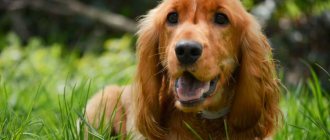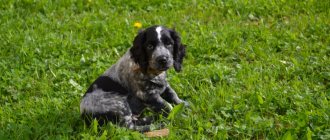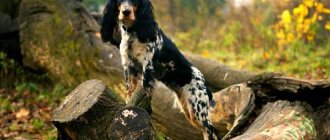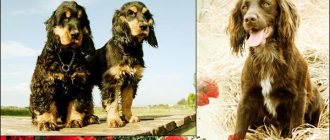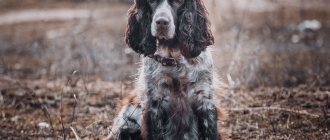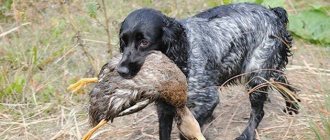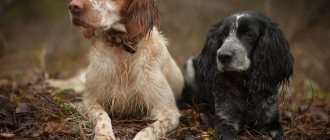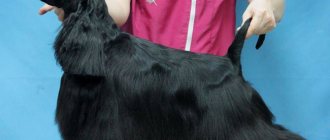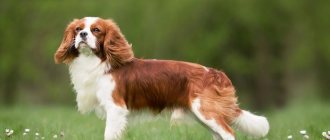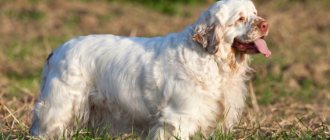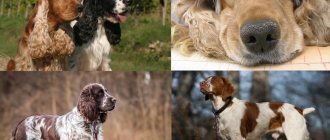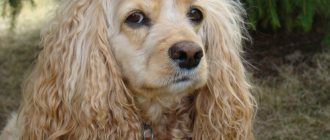First hunt
So, your spaniel is fully prepared for the hunt. The first hunt is a crucial moment in the life of a young dog. Remember that on this day, catching game should not be your main goal, even if it was the long-awaited opening of hunting. The main focus is on the dog.
I do not recommend starting with a spring hunt, where the dog does not work, but only stays next to the owner and serves to feed downed woodcocks. Although the temptation is great: if you took a puppy from an autumn litter, then in April he will already reach “hunting” age. But, alas, the spaniel has not yet gone through the school of training birds in the field, and therefore it is better that the first hunt is associated with the prey of a bird that he himself created.
So, the best time is the opening of the summer-autumn season. I can’t understand why some hunting organizations allow “early” (that is, 2 weeks before the general opening) hunting with pointers and spaniels only for certified dogs - isn’t this the most convenient time for hunting with first-field dogs? In the meadows there are a lot of great snipes, quails and snipe - what a treat for a young spaniel!
Usually the hunt opens at dawn, and most hunters will not miss the dawn, but it is better not to take a spaniel hunting for the first time in his life: there are a lot of people, shots are ringing everywhere, it is hot, and even frightening to an unshot dog, and there are a lot of distractions factors, including other dogs. If you live in a village, leave the spaniel at home, and after the cannonade subsides, return for him and start a normal hunt, preferably for a great snipe or other swamp-meadow game. Of course, everything depends on the land, and for a well-trained spaniel it makes no difference which hunt will be the first. It is advisable to make the first shot only for sure and, like the subsequent ones, only at a bird shot by the spaniel, and not at a noise bird or one that accidentally flew at you. When excited, the spaniel will most likely not pay attention to the loud sound of a shot, and there is practically no danger of scaring the dog with it.
The first outing should not be too long and tiring, even if there was a lot of game. Three birds taken from under a spaniel in 2-3 hours of hunting is an excellent result for a start. Do not forget about the commands, do not run headlong, racing with the dog to the bird that has fallen after being shot, control its obedience. If you are a very temperamental hunter, ask your comrade to play the role of shooter, and you yourself walk without a gun, strictly controlling the dog. Otherwise, your excitement may ruin all the painstaking previous work, and the spaniel will begin to chase all living things to the horizon, wanting to quickly feel the smell of the shot bird and quickly hold it in its mouth.
Well, now – about hunting with a spaniel for various game.
By snipe
Although the classic hunts with a spaniel are ducks and corncrakes, most spanielists rightly prefer the great snipe. The spaniel, unlike the pointers, does not stand, but works short, within the shot, and so expressively that an experienced hunter knows when to expect the bird to take off. Among the three species of royal swamp weevils, the snipe is the most tempting trophy, and not only due to its relatively large size - the work of a spaniel on a snipe is sometimes one of the most beautiful. The lack of a stance on a spaniel does not detract from the beauty of the work itself, as some leggings believe. Of course, there is no sculptural freezing in place with a bent paw, but for spanielists the dog’s manner of working, the spectacular “candles”, the tail rotating like a propeller, signaling the degree of proximity of the bird, and finally, the artistic eyeliner, the throw and noisy rise of the bird provide no less emotional tension, than working as a cop for cops. And here I completely agree with what the famous hunting writer-naturalist Vitaly Bianki, who kept spaniels all his life, wrote half a century ago: “That’s why I didn’t keep pointing dogs, dogs with a stance: it seemed dishonest to me, shackling the bird with fear of the toothy one frozen over it.” beast, slowly approaching the place where she was hiding, and, ordering the dog to lift her on the wing, shoot her in cold blood on takeoff. I preferred spaniels... only those who search for a bird with their instincts and rather help it escape from the hunter than the hunter to shoot it.” This may look somewhat naive, but the fact remains: the more difficult the prey, the more expensive it is for the hunter.
But let's return to the snipe. Hunting for it is especially good at the beginning of the season - in the first half of August and even at the end of July. If the summer is rainy, the snipe lingers until September, but usually after August 20 you will rarely see it. I will also say that the main August prey is young people with females. After the end of mating, adult males remain in the lek area for some time, but already in early August they fly off to distant African wintering grounds. Before this, they wander around the lands for some time, forming summer rashes. That is why in the old days, when hunting opened on Peter’s Day (July 12), great snipe hunting, in the words of S.T. Aksakov, were “fabulously successful” (remember L.N. Tolstoy’s great snipe hunt by Levin and Oblonsky in the novel “Anna Karenina” - it was in July).
The autumn migration of snipes does not occur everywhere in their breeding grounds, but only in some especially feeding grounds for snipes at this time. The peak of migration occurs on Natalia's Day (September 8), also capturing Indian Summer (from September 14 to 21). Dry summers accelerate the departure of great snipes, and in dry autumn there are always few of them.
It is better to go out for great snipe hunting early in the morning, without waiting, as is usually written in hunting guides, “for the dew to dry.” In the summer heat, you need to come to the meadow in complete darkness and wait until dawn: as soon as you can shoot from below, you need to start looking for great snipes, since in such weather they fly away early, even before sunrise, into the support. The spaniel is usually launched against the wind, but it doesn’t matter if there is no wind: he will find the desired smell of the bird from below. The main attention is paid to ensuring that your assistant does not move more than 30-40 meters away from you. As soon as he starts to pause, his tail starts to wag, and you realize that the bird is nearby, come as close to the dog as possible.
Before lifting the bird, the dog makes an approach, changing its move; some spaniels bark, as if warning the hunter that game is nearby. Jump - and now the long-awaited swamp king takes off with the characteristic sound of wings characteristic only of the great snipe! An experienced spaniel will remain in place, only following the bird with his gaze. You release the snipe at 20-30 meters - it’s easy to shoot, but sometimes excessive excitement (after all, it’s a snipe!) leads to annoying mistakes even for experienced hunters. If it is inconvenient to shoot, it is better to refrain from shooting at all: a great snipe usually lands nearby, in front of the hunter, but the one fired at can fly far away, disappearing from sight.
Great snipes hide very tightly: a hunter can walk nearby and three meters away, and the bird will only press closer to the ground. Great snipes love the company of their own kind, so when you find one, take your time and circle around this place, even if, in your opinion, you have already walked around everything here. Sometimes great snipes run into the tall grass on the border with a mown area of the meadow, but after a while they come out into the clear again.
Never shoot through a dog: this is not hunting with a pointer, where you can get close to him. A spaniel can easily be caught with a shot, especially if you use special “scatter” cartridges with dispersal guns, which produce a wide scree already at 10 meters. And remember: the further you are from the dog, the greater the danger of hitting it with a shot. Under no circumstances should you shoot if the dog has chased a great snipe. Here it is necessary to stop and punish her, then calm her down and only then continue the hunt.
Education, training and coaching
A description of the Russian Spaniel breed would be incomplete without mentioning its responsiveness to training.
Training should begin no later than the age of two to three months:
- with simple commands “come to me”, “place”, “sit”, “lie down”;
- distinguishing between what is permitted and what is not allowed using the commands “possible” and “not allowed”.
Hunting skills training
If the dog is planned to be used for hunting, then training, as a rule, also begins in the first months of life:
- from training in “retrieving” game: a 2-3 month old puppy is taught to fetch things at home, a 4-5 month old puppy – on the street and in the water (in the summer);
- learning to search with a shuttle - from 4 to 5 months;
- training the animal for specific types of game - no earlier than 5 - 7 months.
Game training
It is recommended to train your pet for all types of swamp, field and pine forest game. You can proceed with it if you meet the following requirements:
- after identifying the characteristics of the spaniel’s character and behavior;
- after the dog has mastered a minimum of general training techniques and knowledge of basic commands;
- You need to train the puppy alone, do not allow other family members to take the dog out into the countryside, into the forest, to pick “mushrooms” at this time;
- when training, keep the dog in your field of vision, do not let it go more than 40 steps away from you;
- train in places strictly designated for this by the hunting community;
- avoid difficult swamps, swamps, and thick grass when training;
- Protect the dog’s natural sense of smell: stop smoking in its presence, do not keep it near chemicals, and do not feed it spicy food.
For snipe
Snipe hunting with a spaniel has its own characteristics. This bird is often very strict, especially on open mudflats and swamps: even a pointer does not stand on all snipes. Among these waders, it’s as if there are guards who break away when you approach and drag some other relatives with them. This should not confuse you - in snipe rashes there are also birds that tend to hide until the last. Your spaniel continues to work, and for good reason: such snipes usually pull out almost from under his muzzle. The spaniel is required to search carefully and, most importantly, not to run too far ahead of the hunter.
Snipes love swamps that are not overgrown with grass, “rusty” meadow hollows with muddy windows, and partially dry quarries, but in rainy years they often sit in puddles among hayfields and cow pastures. If you find 2-3 snipe swamps in a meadow, you can repeat the hunt for them in almost half an hour or an hour: frightened birds often return to these places again.
Snipe, unlike great snipe, can be hunted all day long even in clear weather: they do not huddle in the support even in the heat. But still, in the morning the hunt is more productive. The best time to hunt snipe is mid-September, the golden days of Indian summer, when there is a massive migration of marsh weevils. If you are lucky, the hunt will be very successful. Sometimes the cartridge belt is not enough for the spaniel to work for half an hour.
Content
Being a “city hunter” dog, the spaniel is adapted to both difficult field conditions (frost, strong wind, rain, heat) and to a small apartment.
The main requirement for his comfortable and happy life at home is:
- long daily walk (an hour and a half a day);
- proper feeding;
- coat care;
- taking care of the health of “problem” ears and eyes.
Feeding
The diet of a Russian spaniel must be balanced and contain all the necessary nutrients and elements.
Good for dogs:
- veal, chicken, chicken liver, boiled beef and chicken offal;
- boiled sea fish fillet;
- vegetables and fruits;
- premium feed.
Adult pets are fed twice a day. Puppies – 5-6 times a day in small portions, avoiding overfeeding.
Care
This breed does not require complex care: the dog must be combed regularly (at least 2-3 times a month), and bathed if necessary.
Taking care of your health
Dogs of this breed are strong, healthy animals.
The weak point is:
- Ears. The dog's long, floppy ears need to be checked and cleaned regularly due to the Spaniel's predisposition to ear infections. The puppy is taught to clean his ears from a very early age;
- Eyes. The eyes often get infected and conjunctivitis develops, so they need to be cleaned of dirt and, if there is watery eyes, rinsed with clean water.
General pet care requirements include: annual vaccination, treatment for parasites, fleas and ticks. Important! The spaniel should not be chained, kept outside in winter, or allowed to overheat or become hypothermic.
On the garnish mud
Garnish is the third species of the royal trio of noble swamp weevils. Hunters love it because it is the latest swamp game in the season. Great snipes have long disappeared, you rarely see a single snipe, in the mornings the swamp is frozen in ice, but hunting with a spaniel for swamp game continues.
You can look for spearfish as early as the twentieth of September, and sometimes even earlier, in marshy muddy swamps. Often such places become former duck meadow lakes and bogs as a result of many years of siltation, aging and drying out. Garcocks are often found in typical snipe swamps, and in rainy years, when the flight of Garcocks is generally more noticeable, they can even be found on rain-drenched stubble in the fields.
The spaniel works with spearfish very enthusiastically, sometimes hotter than with snipe. Garschnep takes off quite quickly and, despite its fluttering flight like a butterfly, it is quite difficult to hit it, especially in the wind. It is difficult to find a downed one even with a dog: it often falls into tall grass, cattails or dense reeds. Of course, an experienced spaniel will find it, although not the first time, but it is better to learn to remember, as accurately as possible, the location of the fall of the expensive prey when hunting for spears. In case of a miss, the spearfish, unlike the snipe, very soon, sometimes in the same swamp, sits down again, even in full view of the dog. The main thing is to prevent the spaniel from quickly getting up before you approach.
And moving through such garnish mud - oh, how difficult it is! His legs are sucked knee-deep into the silt, and the spaniel gets stuck up to his belly in this jelly. Immediately after the end of the hunt, the dog should be bathed in clean water and wiped dry with a terry towel.
Hunting qualities
The Russian Spaniel dog breed is endowed with a whole set of qualities that are indispensable for hunting:
- versatility: the spaniel “works” with almost any type of game;
- compactness: the small size and weight of the spaniel help him to easily get through places where a large dog would get stuck;
- high performance in any weather conditions: the spaniel is not afraid of heat (like, for example, a cop) or complete calm;
- rapid achievement of “hunting” age: a puppy of the autumn litter, with proper training, goes on its first hunt by spring-summer;
- keen sense of smell: the dog will not make a mistake when searching for a wounded animal or a hidden bird; it will find prey in the thickets, in the dark.
Behind the jerks
One of the most interesting hunts with a spaniel is corncrake. I will not be mistaken if I say that in this hunt they have no equal among other breeds of hunting dogs. As you know, the corncrake does not like to hide and runs around a lot when chased by a dog. And although shooting him from under a cop's stance is a common thing, you often come across such sprinters that they can endlessly torment a dog with a firm stance, each time literally running away from under the cop's muzzle. There are no jokes with a spaniel - with candles, jumping, and with his voice he still forces the lazy jerk to rise on the wing.
In the summer, it is better to start hunting corncrakes no earlier than the twentieth of August: before this there are many flightless broods, and during the summer molt, old people, like black grouse and ducks, completely lose the ability to fly for almost three weeks. The best time for hunting is the first half of September. Crakes, both local and migratory, stay in lightly bushed meadows, along reclamation ditches, on the border of mown meadows and unmown areas, along the banks of meadow lakes and ravines.
In clear weather, it is better to hunt in the morning, before the heat sets in, and in the cool of the evening, when the twitchers go to more open places and rise more easily from under the dog. In cloudy weather, as well as during a massive migration, which happens in the middle zone usually in the first ten days of September, you can shoot corncrakes all day. On such days, you usually forget about time and, having gone out at dawn, you often linger with your long-eared fish in the grounds until 3-4 o’clock in the afternoon, when you planned to return by 10 in the morning.
It’s good if the spaniel gives a voice before the bird takes off, is persistent and tireless in pursuing the twitch. With a too phlegmatic spaniel, hunting is less prey and tiring (but it is easier to shoot great snipes with him). Sometimes the dog chases the twitch for up to half an hour or more. Crake literally, like a hare from a hound, runs almost in circles. If the grass is tall, he may never get up despite persistent pursuit. Some hunt all the way, but in such (rather rare) cases I always recall the dog, and we move on to look for another.
Shooting a corncrake is very easy, the main thing is to release it at 20-25 meters and not break it with a close shot. If the crake has risen too far, it is better not to shoot, but to try to raise it again: firstly, you will suffer with wounded creatures, and secondly, it is not difficult to lift a displaced corncrake, and it usually flies off not far away. Even an experienced spaniel cannot catch a light wounded animal in tall, dense grass - it runs like a sprinter! But still, there are few losses of downed corncrakes and spaniels. Especially if the dog is used to frequenting meadows and jerks are your main hunting objects.
Now in most central regions of Russia, where there are floodplains, the number of corncrake is quite high and is even growing slightly from year to year. For many spaniels who are seriously involved in hunting, it comes out on top among all other swamp and meadow game in seasonal prey, perhaps with the exception of quail, the hunting of which is worth talking about separately.
Choosing a puppy
The Russian Spaniel is a faithful friend and companion of man. To purchase a dog with the declared standard for the breed, you should take the choice of a puppy seriously, especially if you plan to take the animal hunting.
Attention should be paid:
- On health, physical characteristics. Russian Hunting Spaniel puppies must be active, well-developed, and well-fed. From two months they stand firmly on their paws, are playful, and curious.
- For compliance with general hunting standards. The animal should not have visible defects: rickets, malocclusion, disproportionate physique (large head, short limbs).
- The puppy’s parents must have all the documents necessary for a purebred dog: a pedigree with an “excellent” exterior grade, a field diploma.
You need to buy a puppy from a trusted professional breeder. This will reduce the likelihood of acquiring a rejected or non-viable dog to a minimum.
By quail
In recent years, there has been a quail boom in most areas. There is information coming from everywhere that there are suddenly a lot of quail. Just five to ten years ago, quail was mainly hunted by hunters in the south of Russia, steppe and forest-steppe zones, and in the Moscow region and nearby regions it was caught relatively rarely. What “helped” was the devastation in agriculture, a sharp reduction in chemical use, an increase in the area of non-mow land and the revival of inconveniences, which have become just convenient (pardon the pun) for many meadow and field birds.
So, you understand where to look for quail. Forbs, abandoned meadows and fields overgrown with weeds - these are their main lands. Quails do not disdain fields of agricultural crops, especially oat, vetch, pea and grain. It is more difficult to raise quails in the rain: they often hide in the bushes and behave there like corncrake runners. Therefore, it is better to hunt in clear, but not hot weather. On cloudy days, you can walk with a spaniel for quails all day, but on a hot afternoon it is difficult both to raise the bird and for the dog to work.
The quail emits a relatively weak odor and runs around a lot while feeding, so the spaniel mainly works from below. The work on broods is especially effective. At the beginning of the summer-autumn season, you will often see a female withdrawing, pretending to be wounded, with small guns - none of the real hunters will raise the hand to make a shot. Later, towards the end of August, the quail quickly gain weight, many broods unite and among the raised flock you will sometimes find young animals of different ages: both large ones, already absolutely indistinguishable from adults, and also small red-legged ones.
When hunting quails, you need to very carefully search the places where they rise: where one rose, others were probably hiding. Sometimes you have to literally spin around in one place, and the spaniel keeps picking up and picking up new quails. If the shot was unsuccessful, the quail usually moves close and soon sits down, especially if it was raised from the brood. The dispersed quails will gather again after some time, so do not rush to leave the quail areas and after a successful hunt, relax with your dog, have a snack nearby and walk through the treasured grounds again. Quails can be hunted almost throughout September, although in the second half of the month there are noticeably fewer birds.
Russian hunting spaniel. Character. Peculiarities. Main features of the breed.
Russian spaniels are very popular dogs in Russia, recognized by the RKF, but not recognized by the FCI. However, the last statement did not in any way affect the success and excellent performance of our native gun all-rounder and a faithful friend of any hunter. Domestic flop-eared people successfully work in the police, the Ministry of Emergency Situations, patrol airports, search for drugs and missing people.
By ducks
When spaniels appeared in our country, their main purpose was duck hunting. Spaniels were bred primarily by duck hunters, and many still keep them for this purpose. Indeed, the spaniel loves water very much, and fetching from water is in his blood.
It is good to hunt duck broods with a spaniel in the first days of the opening of summer-autumn hunting. The water has not yet warmed up, you walk along the edge of a meadow swamp, in which a working spaniel snorts and puffs. He tirelessly examines shallow waters, making his way between hummocks, wading in places, and swimming in others. It can swim for a long time in the thickets along the shore of a lake along which you slowly walk with a gun.
But the spaniel became even more animated, began to bark, jump, and finally, after another barking, one, two, three rose up in front noisily with frantic quacks... and then the entire brood of young, but already heavy-weight mallards!
An experienced trained spaniel in duck areas does not know fatigue and can work for several hours, but at the same time you should not overload, especially a young dog - do not forget about rest and choose the right weather. In the rain or early in the morning, due to dew, if it is not possible to dry, take breaks more often, drying the dog with a towel. In clear, hot weather, you can work longer - the spaniel swims with pleasure in the heat and gets less tired.
Those who say that the spaniel is too weak for duck hunting, unlike, for example, the drathaar, are wrong. It all depends on the fitness of the dog’s body, and spaniels often outperform cops in terms of time spent working in water. Of course, it is difficult for a spaniel to work in water bodies densely overgrown with tall above-water vegetation, but on rafting, an unsteady thick carpet of plants covering some lakes, a spaniel can move without falling through, as if on asphalt. A cop will fail here and will rarely follow a wounded animal or even a dead duck.
Spaniels are very helpful during the evening and morning duck flights: not a single wounded bird will escape from an experienced duckling. In general, spaniels work with great passion on wounded animals: after the start of the hunt, it is enough to walk with the dog through the duck places where the hunters greeted the dawn, and the spaniel will collect for you a hefty bunch of game that was not taken by other hunters.
Many spaniels are excellent at diving for wounded animals. There is no need for special diving training, such as throwing a stick with a weight, etc. Excitement will make the spaniel dive for a wounded animal and, having disappeared under the water, soon appear with a duck in its mouth. By the behavior of the dog, you can determine the degree of proximity of the wounded animal. When she overtakes him, and the duck dives, the spaniel first spins in place, turning his head first to the right, then to the left, looking down, and finally dives. That means the duck is under him, in the water! I have had incredible cases of discovering and catching such very live wounded animals with a spaniel 100-150 meters from the place where the duck fell after being shot.
Duck hunting with a spaniel continues until the very end of the season, until late autumn. But then the dog needs to be protected, avoiding hypothermia.
With a spaniel on different hunts.
Sergei Fokin. Magazine "Nature and Hunting" No. 4 1999
First hunt.
So, your spaniel is fully prepared for the hunt. The first hunt is a crucial moment in the life of a young dog. Remember that on this day, catching game should not be your main goal, even if it was the long-awaited opening of hunting. The main focus is on the dog.
I do not recommend starting with a spring hunt, where the dog does not work, but only stays next to the owner and serves to feed downed woodcocks. Although the temptation is great: if you took a puppy from an autumn litter, then in April he will already reach “hunting” age. But, alas, the spaniel has not yet gone through the school of training birds in the field, and therefore it is better that the first hunt is associated with the prey of a bird that he himself created.
So, the best time is the opening of the summer-autumn season. I can’t understand why our hunting organizations allow “early” (that is, 2 weeks before the general opening) hunting with pointers and spaniels only for certified dogs - isn’t this the most convenient time for hunting with first-field dogs? In the meadows there are a lot of great snipes, quails and snipe - what a treat for a young spaniel!
Usually the hunt opens at dawn, and most hunters will not miss the dawn, but it is better not to take a spaniel hunting for the first time in his life: there are a lot of people, shots are ringing everywhere, it is hot, and even frightening to an unshot dog, and there are a lot of distractions factors, including other dogs. If you live in a village, leave the spaniel at home, and after the cannonade subsides, return for him and start a normal hunt, preferably for a great snipe or other swamp-meadow game. Of course, everything depends on the land, and for a well-trained spaniel it makes no difference which hunt will be the first. It is advisable to make the first shot only for sure and, like the subsequent ones, only at a bird shot by the spaniel, and not at a noise bird or one that accidentally flew at you. As we already said in the previous issue of the magazine, when excited, a spaniel will most likely not pay attention to the loud sound of a shot and there is practically no danger of scaring the dog with it.
The first outing should not be too long and tiring, even if there was a lot of game. Three birds taken from under a spaniel in 2-3 hours of hunting is an excellent result for a start. Do not forget about the commands, do not run headlong, racing with the dog to the bird that has fallen after being shot, control its obedience. If you are a very temperamental hunter, ask your comrade to play the role of shooter, and you yourself walk without a gun, strictly controlling the dog. Otherwise, your excitement may ruin all the painstaking previous work and the spaniel will begin to chase all living things to the horizon, wanting to quickly smell the smell of the shot bird and quickly hold it in its mouth.
Well, now – about hunting with a spaniel for various game.
By the great snipe.
Although the classic hunts with a spaniel are ducks and corncrakes, most spanielists rightly prefer the great snipe. The spaniel, unlike the pointers, does not stand, but works short, within the shot, and so expressively that an experienced hunter knows when to expect the bird to take off. Among the three species of royal swamp weevils, the snipe is the most tempting trophy, and not only due to its relatively large size - the work of a spaniel on a snipe is sometimes one of the most beautiful. The lack of a stance on a spaniel does not detract from the beauty of the work itself, as some leggings believe. Of course, there is no sculptural freezing in place with a bent paw, but for spanielists the dog’s manner of working, the spectacular “candles”, the tail rotating like a propeller, signaling the degree of proximity of the bird, and finally, the artistic eyeliner, the throw and noisy rise of the bird provide no less emotional tension, than working as a cop for cops. And here I completely agree with what the famous hunting writer-naturalist Vitaly Bianki, who kept spaniels all his life, wrote half a century ago: “That’s why I didn’t keep pointing dogs, dogs with a stance: it seemed dishonest to me, shackling the bird with fear of the toothy one frozen over it.” beast, slowly approaching the place where she was hiding, and, ordering the dog to lift her on the wing, shoot her in cold blood on takeoff. I preferred spaniels... only those who search for a bird with their instincts and rather help it escape from the hunter than the hunter to shoot it.” This may look somewhat naive, but the fact remains: the more difficult the prey, the more expensive it is for the hunter.
But let's return to the snipe. Hunting for it is especially good at the beginning of the season - in the first half of August and even at the end of July. If the summer is rainy, the snipe lingers until September, but usually after August 20 you will rarely see it. I will also say that the main August prey is young people with females. After the end of mating, adult males remain in the lek area for some time, but already in early August they fly off to distant African wintering grounds. Before this, they wander around the lands for some time, forming summer rashes. That is why in the old days, when hunting opened on Peter’s Day (July 12), great snipe hunting, in the words of S.T. Aksakov, were “fabulously successful” (remember L.N. Tolstoy’s great snipe hunt by Levin and Oblonsky in the novel “Anna Karenina” - it was in July).
The autumn migration of snipes does not occur everywhere in their breeding grounds, but only in some especially feeding grounds for snipes at this time. The peak of migration occurs on Natalia's Day (September 8), also capturing Indian Summer (from September 14 to 21). Dry summers accelerate the departure of great snipes, and in dry autumn there are always few of them.
It is better to go out for great snipe hunting early in the morning, without waiting, as is usually written in hunting guides, “for the dew to dry.” In the summer heat, you need to come to the meadow in complete darkness and wait until dawn: as soon as you can shoot from below, you need to start looking for great snipes, since in such weather they fly away early, even before sunrise, into the support. The spaniel is usually launched against the wind, but it doesn’t matter if there is no wind: he will find the desired smell of the bird from below. The main attention is paid to ensuring that your assistant does not move more than 30-40 meters away from you. As soon as he starts to pause, his tail starts to wag, and you realize that the bird is nearby, come as close to the dog as possible.
Before lifting the bird, the dog makes an approach, changing its move; some spaniels bark, as if warning the hunter that game is nearby. Jump - and now the long-awaited swamp king takes off with the characteristic sound of wings characteristic only of the great snipe! An experienced spaniel will remain in place, only following the bird with his gaze. You release the snipe at 20-30 meters - it’s easy to shoot, but sometimes excessive excitement (after all, it’s a snipe!) leads to annoying mistakes even for experienced hunters. If it is inconvenient to shoot, it is better to refrain from shooting at all: a great snipe usually lands nearby, in front of the hunter, but the one fired at can fly far away, disappearing from sight.
Great snipes hide very tightly: a hunter can walk nearby and three meters away, and the bird will only press closer to the ground. Great snipes love the company of their own kind, so when you find one, take your time and circle around this place, even if, in your opinion, you have already walked around everything here. Sometimes great snipes run into the tall grass on the border with a mown area of the meadow, but after a while they come out into the clear again.
Never shoot through a dog: this is not hunting with a pointer, where you can get close to him. A spaniel can easily be caught with a shot, especially if you use special “scatter” cartridges with dispersal guns, which produce a wide scree already at 10 meters. And remember: the further you are from the dog, the greater the danger of hitting it with a shot. Under no circumstances should you shoot if the dog has chased a great snipe. Here it is necessary to stop and punish her, then calm her down and only then continue the hunt.
For snipe
Snipe hunting with a spaniel has its own characteristics. This bird is often very strict, especially on open mudflats and swamps: even a pointer does not stand on all snipes. Among these waders, it’s as if there are guards who break away when you approach and drag some other relatives with them. This should not confuse you - in snipe rashes there are also birds that tend to hide until the last. Your spaniel continues to work, and for good reason: such snipes usually pull out almost from under his muzzle. The spaniel is required to search carefully and, most importantly, not to run too far ahead of the hunter.
Snipes love swamps that are not overgrown with grass, “rusty” meadow hollows with muddy windows, and partially dry quarries, but in rainy years they often sit in puddles among hayfields and cow pastures. If you find 2-3 snipe swamps in a meadow, you can repeat the hunt for them in almost half an hour or an hour: frightened birds often return to these places again.
Snipe, unlike great snipe, can be hunted all day long even in clear weather: they do not huddle in the support even in the heat. But still, in the morning the hunt is more productive. The best time to hunt snipe is mid-September, the golden days of Indian summer, when there is a massive migration of marsh weevils. If you are lucky, the hunt will be very successful. Sometimes the cartridge belt is not enough for the spaniel to work for half an hour.
On the garnish mud
Garnish is the third species of the royal trio of noble swamp weevils. Hunters love it because it is the latest swamp game in the season. Great snipes have long disappeared, you rarely see a single snipe, in the mornings the swamp is frozen in ice, but hunting with a spaniel for swamp game continues.
You can look for spearfish as early as the twentieth of September, and sometimes even earlier, in marshy muddy swamps. Often such places become former duck meadow lakes and bogs as a result of many years of siltation, aging and drying out. Garcocks are often found in typical snipe swamps, and in rainy years, when the flight of Garcocks is generally more noticeable, they can even be found on rain-drenched stubble in the fields.
The spaniel works with spearfish very enthusiastically, sometimes hotter than with snipe. Garschnep takes off quite quickly and, despite its fluttering flight like a butterfly, it is quite difficult to hit it, especially in the wind. It is difficult to find a downed one even with a dog: it often falls into tall grass, cattails or dense reeds. Of course, an experienced spaniel will find it, although not the first time, but it is better to learn to remember, as accurately as possible, the location of the fall of the expensive prey when hunting for spears. In case of a miss, the spearfish, unlike the snipe, very soon, sometimes in the same swamp, sits down again, even in full view of the dog. The main thing is to prevent the spaniel from quickly getting up before you approach. And moving through such garnish mud is oh, how difficult it is! His legs are sucked knee-deep into the silt, and the spaniel gets stuck up to his belly in this jelly. Immediately after the end of the hunt, the dog should be bathed in clean water and wiped dry with a terry towel.
Behind the jerks
One of the most interesting hunts with a spaniel is corncrake. I will not be mistaken if I say that in this hunt they have no equal among other breeds of hunting dogs. As you know, the corncrake does not like to hide and runs around a lot when chased by a dog. And although shooting him from under a cop's stance is a common thing, you often come across such sprinters that they can endlessly torment a dog with a firm stance, each time literally running away from under the cop's muzzle. There are no jokes with a spaniel - with candles, jumping, and with his voice he still forces the lazy jerk to rise on the wing.
In the summer, it is better to start hunting corncrakes no earlier than the twentieth of August: before this there are many flightless broods, and during the summer molt, old people, like black grouse and ducks, completely lose the ability to fly for almost three weeks. The best time for hunting is the first half of September. Crakes, both local and migratory, stay in lightly bushed meadows, along reclamation ditches, on the border of mown meadows and unmown areas, along the banks of meadow lakes and ravines.
In clear weather, it is better to hunt in the morning, before the heat sets in, and in the cool of the evening, when the twitchers go to more open places and rise more easily from under the dog. In cloudy weather, as well as during a massive migration, which happens in the middle zone usually in the first ten days of September, you can shoot corncrakes all day. On such days, you usually forget about time and, having gone out at dawn, you often linger with your long-eared fish in the grounds until 3-4 o’clock in the afternoon, when you planned to return by 10 in the morning.
It’s good if the spaniel gives a voice before the bird takes off, is persistent and tireless in pursuing the twitch. With a too phlegmatic spaniel, hunting is less prey and tiring (but it is easier to shoot great snipes with him). Sometimes the dog chases the twitch for up to half an hour or more. Crake literally, like a hare from a hound, runs almost in circles. If the grass is tall, he may never get up despite persistent pursuit. Some hunt all the way, but in such (rather rare) cases I always recall the dog, and we move on to look for another.
Shooting a corncrake is very easy, the main thing is to release it at 20-25 meters and not break it with a close shot. If the crake has risen too far, it is better not to shoot, but to try to raise it again: firstly, you will suffer with wounded creatures, and secondly, it is not difficult to lift a displaced corncrake, and it usually flies off not far away. Even an experienced spaniel cannot catch a light wounded animal in tall, dense grass - it runs like a sprinter! But still, there are few losses of downed corncrakes and spaniels. Especially if the dog is used to frequenting meadows and jerks are your main hunting objects.
Now in most central regions of Russia, where there are floodplains, the number of corncrake is quite high and is even growing slightly from year to year. For many spaniels who are seriously involved in hunting, it comes out on top among all other swamp and meadow game in seasonal prey, perhaps with the exception of quail, the hunting of which is worth talking about separately.
By quail
In the last two years, a quail boom has occurred in most areas of Central Russia. There is information coming from everywhere that there are suddenly a lot of quail. Just five to ten years ago, quail was mainly hunted by hunters in the south of Russia, steppe and forest-steppe zones, and in the Moscow region and nearby regions it was caught relatively rarely. What “helped” was the devastation in agriculture, a sharp reduction in chemical use, an increase in the area of non-mow land and the revival of inconveniences, which have become just convenient (pardon the pun) for many meadow and field birds.
So, you understand where to look for quail. Forbs, abandoned meadows and fields overgrown with weeds - these are their main lands. Quails do not disdain fields of agricultural crops, especially oat, vetch, pea and grain. It is more difficult to raise quails in the rain: they often hide in the bushes and behave there like corncrake runners. Therefore, it is better to hunt in clear, but not hot weather. On cloudy days, you can walk with a spaniel for quails all day, but on a hot afternoon it is difficult both to raise the bird and for the dog to work.
The quail emits a relatively weak odor and runs around a lot while feeding, so the spaniel mainly works from below. The work on broods is especially effective. At the beginning of the summer-autumn season, you will often see a female withdrawing, pretending to be wounded, with small guns - none of the real hunters will raise the hand to make a shot. Later, towards the end of August, the quail quickly gain weight, many broods unite and among the raised flock you will sometimes find young animals of different ages: both large ones, already absolutely indistinguishable from adults, and also small red-legged ones.
When hunting quails, you need to very carefully search the places where they rise: where one rose, others were probably hiding. Sometimes you have to literally spin around in one place, and the spaniel keeps picking up and picking up new quails. If the shot was unsuccessful, the quail usually moves close and soon sits down, especially if it was raised from the brood. The dispersed quails will gather again after some time, so do not rush to leave the quail areas and after a successful hunt, relax with your dog, have a snack nearby and walk through the treasured grounds again. Quails can be hunted almost throughout September, although in the second half of the month there are noticeably fewer birds.
By ducks
When spaniels appeared in our country, their main purpose was duck hunting. Spaniels were bred primarily by duck hunters, and many still keep them for this purpose. Indeed, the spaniel loves water very much, and fetching from water is in his blood.
It is good to hunt duck broods with a spaniel in the first days of the opening of summer-autumn hunting. The water has not yet warmed up, you walk along the edge of a meadow swamp, in which a working spaniel snorts and puffs. He tirelessly examines shallow waters, making his way between hummocks, wading in places, and swimming in others. It can swim for a long time in the thickets along the shore of a lake along which you slowly walk with a gun.
But the spaniel became even more animated, began to bark, jump, and finally, after another barking, one, two, three rose up in front noisily with frantic quacks... and then the entire brood of young, but already heavy-weight mallards!
An experienced trained spaniel in duck areas does not know fatigue and can work for several hours, but at the same time you should not overload, especially a young dog - do not forget about rest and choose the right weather. In the rain or early in the morning, due to dew, if it is not possible to dry, take breaks more often, drying the dog with a towel. In clear, hot weather, you can work longer - the spaniel swims with pleasure in the heat and gets less tired.
Those who say that the spaniel is too weak for duck hunting, unlike, for example, the drathaar, are wrong. It all depends on the fitness of the dog’s body, and spaniels often outperform cops in terms of time spent working in water. Of course, it is difficult for a spaniel to work in water bodies densely overgrown with tall above-water vegetation, but on rafting, an unsteady thick carpet of plants covering some lakes, a spaniel can move without falling through, as if on asphalt. A cop will fail here and will rarely follow a wounded animal or even a dead duck.
Spaniels are very helpful during the evening and morning duck flights: not a single wounded bird will escape from an experienced duckling. In general, spaniels work with great passion on wounded animals: after the start of the hunt, it is enough to walk with the dog through the duck places where the hunters greeted the dawn, and the spaniel will collect for you a hefty bunch of game that was not taken by other hunters.
Many spaniels are excellent at diving for wounded animals. There is no need for special diving training, such as throwing a stick with a weight, etc. Excitement will make the spaniel dive for a wounded animal and, having disappeared under the water, soon appear with a duck in its mouth. By the behavior of the dog, you can determine the degree of proximity of the wounded animal. When she overtakes him, and the duck dives, the spaniel first spins in place, turning his head first to the right, then to the left, looking down, and finally dives. That means the duck is under him, in the water! I have had incredible cases of discovering and catching such very live wounded animals with a spaniel 100-150 meters from the place where the duck fell after being shot.
Duck hunting with a spaniel continues until the very end of the season, until late autumn. But then the dog needs to be protected, avoiding hypothermia.
According to grouse broods
One of the most vivid, memorable and beautiful hunts with a spaniel is through broods of grouse. This hunt occurs only in August. Young grouse almost reach the size of adults, especially at the end of the month. The cockerels are already clearly distinguishable from the hens by their black feathers and are immediately noticeable in the brood. Therefore, many, especially local, hunters, when hunting with a spaniel in the summer, first of all try to shoot blacklings, and prefer not to touch the chickens.
Broods of grouse live along the edges of oat fields, on clovers, and among forbs. They are very fond of abandoned, overgrown fields and wastelands, forest glades and berry patches. During the day, in the heat, black grouse often huddle in the support, where they sit under trees and bushes and it is difficult to drive them out of there. The best time for hunting is early morning and before the evening dawn. You are walking, for example, through a field overgrown with short grass, with “spots” of clover. In front, your spaniel works the shuttle. Now his move changed: his tail started working three times more often, the dog spun in place and, quickly untangling the fat, confidently led you into the St. John's wort clump. Eyeliner, clucking, jumping - and the deafening flapping of grouse wings. A successful doublet - and a pair of black and red cockerels in your bag.
It's amazing how black grouse hide! Old little blackies sometimes run in front of the dog for a long time and take off almost from under the muzzle! Last year, I and my Paw came to a friend’s grouse hunt in a distant village at the very end of August. The broods were already pretty beaten - from the opening Sergei took 18 black grouse. Nevertheless, the hunt was successful: in two days, Lapka and I took 8 birds! One old rooster tormented the dog for twenty minutes - he ran forward, hid, came back, but did not take off. And he flew out from under the dog just a meter away from me in such low clover that I’m still surprised how I couldn’t notice him before takeoff. Needless to say, hunting grouse without a dog is impossible.
On woodcock rashes
From the end of September to mid-October, one of the most beautiful and poetic hunts with a spaniel takes place - on woodcock rashes. At this time, both local and migratory woodcocks seem to pour out of the supports, where they stayed in the summer and early autumn, into open places - coppices, individual clumps of bushes in the meadow, on the edges of fields, small forests and overgrown clearings. At night, they fly out to feed in cow pastures with low numbers, so the best woodcock habitats should be found in areas of the forest where cattle graze nearby. It is difficult to shoot a bird flashing among the trees and bushes, but the prey is even more expensive for the hunter.
Unlike a pointing spaniel, he works short in the forest, he is not hidden from view, and he does not need to hang a bell to indicate the dog’s location. As a rule, all the work is done within the shot, and as soon as you see that the dog is working on the woodcock, you can come closer. Sometimes, however, woodcocks run as fast as they can from the pursuing spaniel (which I have observed more than once) and rise far away, out of range of the shot, also shielded by a tree. But among the woodcocks there are also those who prefer to hide until the last, flying up in close proximity to the dog, making a candle. After a miss, you need to walk with the dog in the direction where the woodcock disappeared - often wounded woodcocks, and even completely beaten woodcocks manage to fly away, but an experienced spaniel will still find precious prey. How many times, having made, as it seemed to me, an obvious mistake, I wandered with regret towards a woodcock hidden in the branches, when suddenly I noticed my spaniel with a woodcock in its mouth!
Wood waders are rarely seen alone in autumn, so if one rises, look for fellow birds nearby. The spaniel is very warm towards the woodcock - he works passionately, and when the bird rises, many give a voice. The smell of woodcock makes the little spaniel work in dense thickets, where a large pointer can’t get through, and crawl under roots and fallen trees. Hunting often goes like this: you stand on a forest road or clearing, and the spaniel works from the edge, in the forest. A woodcock that takes off ends up in the clear, and shooting it is no longer difficult. From the outside, it looks like the spaniel is chasing woodcocks at the hunter.
On other hunts
There are many more types of hunting with a spaniel. I talked about the most famous ones to me. Crakes and swamp hens are hunted in almost the same way as corncrakes, except that they choose damper swamps with barrels filled with water. Hunting for gray partridge is similar to quail, but the birds sometimes stay in very large broods, taking off with great noise and crackling, synchronously maneuvering in flight, and often landing again as a whole flock 100-200 meters from the place of rise. The smell of gray partridge is very strong, especially if the brood is fattening. One evening in October, my dog and I were returning home from a not very successful hunt: only woodcock and snipe were hanging out in the bag's bag. Suddenly, on a road passing by the edge of an abandoned field, a dog suddenly pulled into the field, literally squealing with excitement. It was the wind that brought to her the smell of feeding partridges. I let the spaniel off the leash, he rushed about 100 meters into the weeds and, of course, killed an almost fifty-hundred flock of gray partridges outside the shot. I noticed where they were landing. The fatigue was gone. Having calmed the dog, he began the hunt. The brood rose three more times, some birds lingered, and in total we took five birds that evening. The pilaf turned out excellent!
Hunting for wood grouse broods is similar to a similar hunt for black grouse, with the only difference being that it takes place in more difficult forest areas, wood grouse run more, fly farther and are incomparably more difficult to catch than black grouse.
They hunt with a spaniel for curlews, turukhtans, snails and other waders. I can’t say anything about pheasant hunting, but I know that here, too, the spaniel helps the hunter well.
During the spring hunt, the spaniel is indispensable for searching for downed woodcocks while being pulled. He quickly learns to understand the voice of a drawing woodcock and behave calmly next to the hunter, without disturbing him to listen to the evening forest and wait for the woodcock to approach. On other spring hunts, the main purpose of the spaniel is to search for wounded animals and dead birds at the end of the hunt. You can read more about this in the magazine “Hunting Dogs”, No. 3, 1999.
Some people hunt hares along the black trail with a spaniel. In my life I have taken three birds with one stone from under them, but I must say that this is not their game. Yes, a spaniel can chase in small circles, the hare moves out from under it slowly, but during this hunt the dog completely loses contact with the owner, which is undesirable. Remember, we said that the spaniel should work all the time with an eye on the owner, not moving further away than a reliable shot. Hunting hares spoils the dog in this regard. I also cannot understand the need for a spaniel to work on a blood trail, which has been propagated lately. I knew spaniels that were excellent at working on ungulates. But you must admit, there is a limit to versatility and there are traditional dog breeds for hunting animals, but it is better for a spaniel to concentrate its efforts on game birds.
On woodcock rashes
From the end of September to mid-October, one of the most beautiful and poetic hunts with a spaniel takes place - on woodcock rashes. At this time, both local and migratory woodcocks seem to pour out of the supports, where they stayed in the summer and early autumn, into open places - coppices, individual clumps of bushes in the meadow, on the edges of fields, small forests and overgrown clearings. At night, they fly out to feed in cow pastures with low numbers, so the best woodcock habitats should be found in areas of the forest where cattle graze nearby. It is difficult to shoot a bird flashing among the trees and bushes, but the prey is even more expensive for the hunter.
Unlike a pointing spaniel, he works short in the forest, he is not hidden from view, and he does not need to hang a bell to indicate the dog’s location. As a rule, all the work is done within the shot, and as soon as you see that the dog is working on the woodcock, you can come closer. Sometimes, however, woodcocks run as fast as they can from the pursuing spaniel (which I have observed more than once) and rise far away, out of range of the shot, also shielded by a tree. But among the woodcocks there are also those who prefer to hide until the last, flying up in close proximity to the dog, making a candle. After a miss, you need to walk with the dog in the direction where the woodcock disappeared - often wounded woodcocks, and even completely beaten woodcocks manage to fly away, but an experienced spaniel will still find precious prey. How many times, having made, as it seemed to me, an obvious mistake, I wandered with regret towards a woodcock hidden in the branches, when suddenly I noticed my spaniel with a woodcock in its mouth!
Wood waders are rarely seen alone in autumn, so if one rises, look for fellow birds nearby. The spaniel is very warm towards the woodcock - he works passionately, and when the bird rises, many give a voice. The smell of woodcock makes the little spaniel work in dense thickets, where a large pointer can’t get through, and crawl under roots and fallen trees. Hunting often goes like this: you stand on a forest road or clearing, and the spaniel works from the edge, in the forest. A woodcock that takes off ends up in the clear, and shooting it is no longer difficult. From the outside, it looks like the spaniel is chasing woodcocks at the hunter.
Key facts
The Russian Spaniel is an energetic, lively, inquisitive, optimistic and friendly pet. Nature has endowed the dog with excellent sense of smell and amazing endurance, which allows it to quickly and easily find birds in marshy or dry areas.
The spaniel is an incredibly smart, loyal and obedient dog that is strongly attached to its owner. He gets along well with small children, cats, dogs, and other pets. Such a pet will be an ideal companion for an active family and is definitely not suitable for elderly and constantly busy people.
Description of the Russian Hunting Spaniel breed includes:
high level of intelligence;
well developed hunting qualities;
easy training and education;
rapid adaptation to a new environment;
unpretentiousness in everyday maintenance, nutrition, care.
If the spaniel is considered in the role of a hunter, it is worth noting such qualities as: perseverance, activity, endurance and complete obedience. The pet swims well in water, dives, and follows all the owner’s commands if it is raised correctly.
The characteristics of the Russian hunting spaniel breed emphasize that this hunting dog is hardy, energetic, patient, persistent and at the same time attached to the owner and his family.
With proper maintenance and proper nutrition, the life expectancy of the Russian Hunting Spaniel is 9-11 years. For a hunting dog this is a normal period. Long-livers occur, but not so often.
The spaniel tolerates cold well, which makes it possible to keep it in the enclosure of a private house. In the winter season, the owner needs to take care of insulating the booth, since without the proper conditions the dog can get sick.
On other hunts
There are many more types of hunting with a spaniel. I talked about the most famous ones to me. Crakes and swamp hens are hunted in almost the same way as corncrakes, except that they choose damper swamps with barrels filled with water. Hunting for gray partridge is similar to quail, but the birds sometimes stay in very large broods, taking off with great noise and crackling, synchronously maneuvering in flight, and often landing again as a whole flock 100-200 meters from the place of rise. The smell of gray partridge is very strong, especially if the brood is fattening. One evening in October, my dog and I were returning home from a not very successful hunt: only woodcock and snipe were hanging out in the bag's bag. Suddenly, on a road passing by the edge of an abandoned field, a dog suddenly pulled into the field, literally squealing with excitement. It was the wind that brought to her the smell of feeding partridges. I let the spaniel off the leash, he rushed about 100 meters into the weeds and, of course, killed an almost fifty-hundred flock of gray partridges outside the shot. I noticed where they were landing. The fatigue was gone. Having calmed the dog, he began the hunt. The brood rose three more times, some birds lingered, and in total we took five birds that evening. The pilaf turned out excellent!
Hunting for wood grouse broods is similar to a similar hunt for black grouse, with the only difference being that it takes place in more difficult forest areas, wood grouse run more, fly farther and are incomparably more difficult to catch than black grouse.
They hunt with a spaniel for curlews, turukhtans, snails and other waders.
I can’t say anything about pheasant hunting, but I know that here, too, the spaniel helps the hunter well.
During the spring hunt, the spaniel is indispensable for searching for downed woodcocks while being pulled. He quickly learns to understand the voice of a drawing woodcock and behave calmly next to the hunter, without disturbing him to listen to the evening forest and wait for the woodcock to approach. On other spring hunts, the main purpose of the spaniel is to search for wounded animals and dead birds at the end of the hunt.
Some people hunt hares along the black trail with a spaniel. During my life I took three birds with one stone from under them, but I must say that this is still not their game. Yes, a spaniel can chase in small circles, the hare moves out from under it slowly, but during this hunt the dog completely loses contact with the owner, which is undesirable. Remember, we said that the spaniel should work all the time with an eye on the owner, not moving further away than a reliable shot. Hunting hares spoils the dog in this regard. I also cannot understand the need for a spaniel to work on a blood trail, which has been propagated lately. I knew spaniels that were excellent at working on ungulates. But you must admit, there is a limit to versatility and there are traditional dog breeds for hunting animals, but it is better for a spaniel to concentrate its efforts on game birds.
Sergey Fokin
